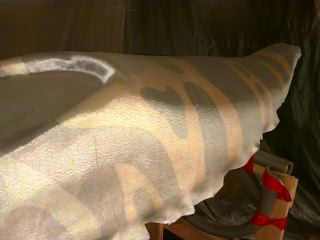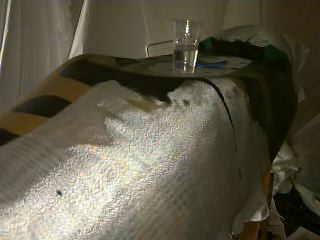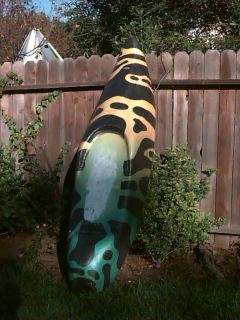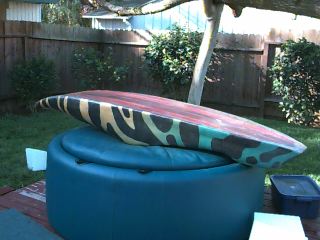

I prefered a heavy boat to a broken boat so I used a schedule of:
This actually ended up being just about right I think, and not too heavy.
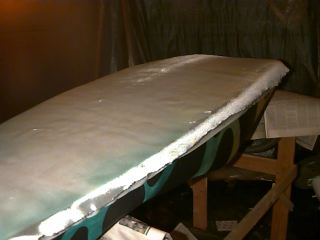 The first step was to cut the glass to overlap the rails, and then mask off the rest of the shape from resin drops. Ideally the glass should just overlap the masking tape.
The first step was to cut the glass to overlap the rails, and then mask off the rest of the shape from resin drops. Ideally the glass should just overlap the masking tape.
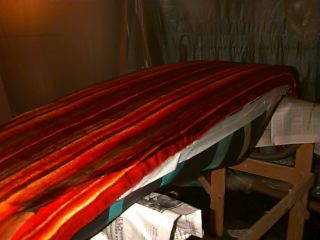 Then I layed in the fabric. I wasn't sure of the best way to do this - whether I should lay it up with the glass, or ahead of time - or what. I decided to put on a light coat of epoxy, roll out the fabric and then use a razor to cut the shape of the cloth so that things would line up reasonably well. The fabric was 'stretchy' enough that I didn't want to precut the precise shape and assume I'd be able to laminate it exactly into place. Unlike the fiberglass there would be no trimming and no overlap on the rails.
Then I layed in the fabric. I wasn't sure of the best way to do this - whether I should lay it up with the glass, or ahead of time - or what. I decided to put on a light coat of epoxy, roll out the fabric and then use a razor to cut the shape of the cloth so that things would line up reasonably well. The fabric was 'stretchy' enough that I didn't want to precut the precise shape and assume I'd be able to laminate it exactly into place. Unlike the fiberglass there would be no trimming and no overlap on the rails.
I layed a thin enough coat of epoxy to hold the cloth in place and then I started hitting problems. The weave of the fabric was tough enough that even a brand new razor blade was not making a clean cut without dragging the fabric out of place and creating wrinkles. I had to opt for an emergency plan B and grabbed the scissors. This didn't result in the most even of cuts, and it wasn't a good omen for things to come during the rest of the day.
I intended for the fabric not to get saturated so that I could layout and align the fiberglass I had already cut to the shape without it sticking. I lined all the fiberglass layers OK and mixed a new batch of epoxy. I poured the resin down the centerline and quickly spread it around the bottom. Then I think a combination of things started to go wrong.
When the cloth is wetted out properly you can easily see the fabric. The center line where I poured the epoxy was nice and clear but in many other places on the bottom the glass was still partially to completely opaque, and I had used up nearly all the resin batch. I think that the fabric and some small imperfections below the fabric absorbed more resin than I counted on, as did the layup itself. I only had about 40 minutes to work, and most of that time should have been spent getting the rails wetted out. Also I had been too hasty in laying out the cloth and left some shallow wrinkles that were harder to work out than I thought. I also found that airbubbles took a lot a patience to get out. I had to mix 2 more batches of epoxy and use a hair drier to get the bottom fully wetted out and started to get the rails going but then ran out of time. I found it much harder then I expected to get the rails wrapped as it is a curved and vertical surface and its hard to get the resin to soak in without running onto the floor. So rather than get the rails wrapped 2-3 inches as I had planned I got maybe only and inch towards the front, and basically not at all along the tail where the edge is harder. I found that doing small test layups didn't prepare me for everything I encountered in laying up the real thing. Having 2 or even 3 people do this part would make things less stessfull - as it was I was sweating bullets and definitely scared when I saw I had some bad saturation problems and even voids. I almost decided to abort and rip off the whole bunch of fiberglass to try again another day - but in the end I rescued it somewhat. In someways the fabric inlay was good as it easily let me see where I was having saturation problems. What I would have done differently, is made up more epoxy early on rather than try to work the resin I had poured as much as I did. Also experience counts for a lot here. Also it is far easier to smooth out the glass when it is dry and you have no time constraints, and this makes wetting out the layup much smoother.
I used a small grinding disk drill bit to feather the rough edge and then cut the glass for the deck. Lining up the first layer with the lapped glass from the bottom and trimming - then lapping 2 more layers around onto the bottom. I wasn't able to get the glass to follow the curves around my recessed cockpit area very well, and ended up with some air bubbles. I found it easies to cut areas of high curvature as I was wetting things out rather than when I hung the cloth. Also I tended to cut simple straight cuts and then overlap glass rather than cut triangular 'darts' out of the material.
